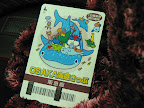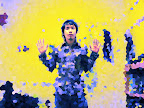Back number: found in my harddrive

Here is an unposted entry, written on 6/22/2007
Japanese Cutism
I saw a poster in the train and finally on Wednesday I was after the smiley whale shark and his very cute friends from the ocean at Osaka Aquarium (picture below). I have been there two years ago, just in its souvenir shop, not inside though, because there was only 30 minutes left until the gate closed. The design of the stuffed animals and several gadgets based on the members of the aquarium impressed me the best. As I said I didn't get inside the aquarium but I couldn't help buying a little smiley jellyfish stuffed animal home. This time again, I couldn't resist the smiley cartoon of the whale shark on the poster which invites me to see the real one while chances exist per my stay in Japan.
The real whale shark (whose name I found out to be "Umi-kun") was huge and very adorable in his own way. I could see subtle smile on his face as well as others' such as the dish fish (kraben in Thai), especially the one I called "Mr. sharp face" who has a smart, handsome face. Anyway, back to the point of this post is I want to ask about how Japanese seems to cartoonize everything (creatures, characters, humans) to make its pop culture and why they appear so (drop dead) cute. This cartoonistic Cutism is very pervasive in Japan. You go to a park and you see a sign of cute personified dog warning its owner to clean after its poop; you go to a temple and see little statues and dolls of cartoonish monks or even big round-headed smiley Buddha in its souvenir shop. Among these two questions, I don't know really how to answer the first one. Anybody can say that it comes from the grass root animistic national Shinto culture that tends to personify everything including inanimate objects, but how many Japanese actually believes in this religion nowadays? Or why did they not have these cute yet abstract designs for animals and objects back in its medieval era? I haven't mentioned the fact that most cultures, at least in Asian countries, have their own mythological, animistic past, even the Greeks; and when I think about it, ancient Asian art usually appears abstract and stylized, as opposed to the continual pursuit of (outer or inner) realism of the West.
I find it interesting when I try the second question about the Japanese obsession with cuteness in its pop culture. Umi-kun look super cute, (and I acknowledge this point, indeed) in the poster particularly because his design is unrealistic. The Kurage-kun jellyfish I got on my desk is adorable because it winks, smiles and can stand on his little feet instead of waving his tenuous long tentacles. I don't know how a Japanese exactly perceive a cat when she see a real one. Does it take similarity to Hello Kitty or other ones she has seen in anime?
I still have a green mossy grandpa Morizou and grandson Kikkoro sticker from Aichi World Expo two years ago (which remain ones of my favorite characters, also very cute) posted on my laptop. They supposed to represent nature although through their highly abstract form, I doubt if they rather represent an imagined nostalgia; a love for a distorted image of nature? I believe there must be some of the most dedicated hardcore environmentalists among the Japanese, but to the mainstream people, does nature exist exclusively for humans? Woods are for human to feel good about himself, an idolized haven to relax in, but not for animals to live, whereas animals are for human to consume and to keep as pets, disposable when not needed. They eat; they poop and make cities dirty but sometimes they pretentiously give human proximal connection to nature; their beastly appearance makes perfect decorations to our artificially pristine haven. If that is so, this pretentiousness shows perhaps not how close human has come back to nature but rather how distant he is to it.



0 Comments:
Post a Comment
<< Home